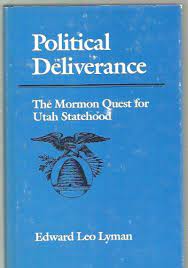Articles/Essays – Volume 21, No. 1
Politicians, Mormons, Utah, and Statehood | Edward Leo Lyman, Political Deliverance: The Mormon Quest for Utah Statehood
Few states in the union had a longer or more bitterly contested statehood struggle than did Utah. Edward Leo Lyman has searched out and chronicled the detail, factors, and individuals which make up the drama in Political Deliverance: The Mormon Quest for Utah Statehood.
As Leonard Arrington notes in his introduction to this definitive study, “[Lyman] provides so much new data from so many previously unmined sources that the popular understanding of how plural marriage began to be abandoned and how statehood came to Zion will have to be reassessed” (p. ix). Still, Lyman’s work is based on the foundation of earlier studies of the statehood and polygamy issue including Leonard Arrington’s 1958 Great Basin Kingdom, Howard LaMar’s section on Utah in his 1966 volume, The Far Southwest: 1846-1912, A Territorial History, Klaus Hansen’s 1967 Quest for Empire, Gustive O. Larson’s 1970 The “Americanization” of Utah for Statehood, and Henry J. Wolfinger’s 1971 “A Reexamination of the Woodruff Manifesto in the Light of Utah Constitutional History.”
The 1890 Wilford Woodruff Manifesto was not so much a revelation or decisive announcement to end polygamy, rather a political strategy to gain statehood and pre vent the enactment of the Cullom-Struble Bill which would have disenfranchised all persons belonging to a church organization that taught or practiced polygamy.
With these points outlined clearly in his introduction, Lyman proceeds to review events and circumstances related to state hood from 1849 to 1896. For some readers, the detail may be overwhelming and uninteresting. But those who persist will find a stimulating lesson in nineteenth-century politics including the role of lobbyists and the debts that they expected to collect for their services. They will also find that the political opponents of Utah’s statehood were not so much anti-Mormon as anti-polygamy.
While the quest for statehood occupies center stage, other interesting sub-themes add richness to Lyman’s study. These include the demise of the People’s and Liberal parties; the emergence of the Democratic and Republican parties in Utah; nationally the shift of political sup port for statehood from the Democratic to the Republican party; the manner in which Mormons and gentiles came together in national parties; the ambivalence of Church leaders toward political participation by their fellows; the ease with which Mormons were drawn into the practice of slinging political mud at each other; and how Church leaders were1 unable to keep promises or at least fill the political expectations of loyal lobbyists like Isaac Trumbo.
While acknowledging Wolfinger’s pioneering work in bringing to light the negotiations and political concessions made by Church leaders to federal government officials before the Manifesto, Lyman challenges Hansen’s thesis regarding the preeminence of the Council of Fifty in the fight for statehood and Gustive O. Larson’s view that polygamy was primarily a weapon used by opponents to destroy the political power wielded by Church leaders. Lyman finds that the first presidency, not the Council of Fifty, was the primary Mormon group concerned with economic and political affairs in Utah during the 1880s and 1890s. Lyman observes that critics of statehood did not mandate “cessation of political activity by the Mormon hierarchy [but the] regularization of political affairs in Utah” (p. 3). This meant the breakup of the Mormon People’s party and the Gentile Liberal party and the amalgamation of political activities across religious lines within the Republican and Democratic Parties.
Acknowledging that plural marriage presented the greatest barrier to statehood for Utah, Lyman credits historians with recognizing the importance of the polygamy issue and cites the conclusion of Orson F. Whitney in his History of Utah that if Mormons had abandoned polygamy in 1862, the Republican party probably would have supported Utah’s statehood application at that time. Lyman finds that polygamy was not on the wane in the late years of the century and concludes that without the anti-polygamy raid plural marriage “would have continued to flourish, at least among the Mormon elite . . . for at least another generation” (p. 4).
Students of Mormon History and nineteenth-century political history will find Political Deliverance indispensable to an understanding of the statehood process for Utah and the compromises and concessions that Church leaders had to make to attain that long-sought goal.
Political Deliverance: The Mormon Quest for Utah Statehood by Edward Leo Lyman (Urbana and Chicago: University of Illinois Press, 1986), 327 pp. $22.50.


 Back to full Issue
Back to full Issue

